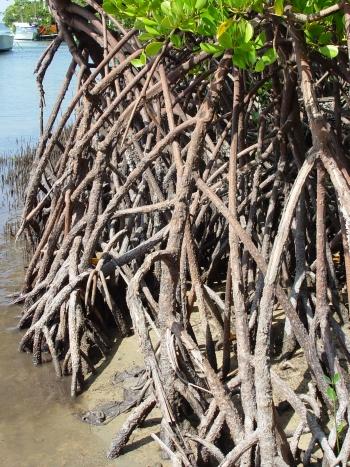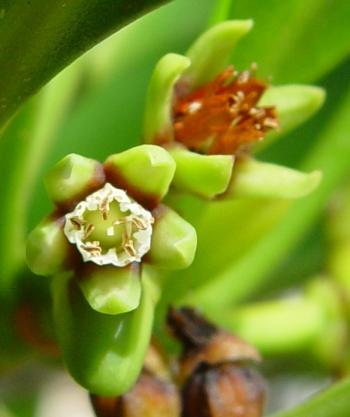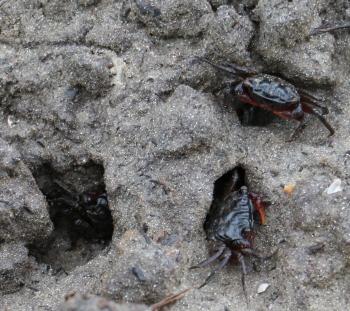Ceriops tagal
Ceriops tagal (Perr.) C.B.Rob
Family: Rhizophoraceae
Common names: Indian mangrove (Eng), Indiese wortelboom (Afr), isinkaha (Zul.)
SA Tree No: 525
Introduction
A compact branched tree or shrub with a distinctive root growth, fascinating growth habit and seeds, occurring in the tidal estuaries, lagoons and swamps, as a member of mangrove forest.

Description
Description
Ceriops tagal is a shrub or small tree with compact crown. It usually grows up to 6 m. Bark flecking, light grey, smooth with buttress roots and thin breathing roots.

Branches are large, thick and almost fleshy, and marked with scars. Leaves are large, opposite and at right angles to the next pair, thickly leathery to almost fleshy, yellowish green, with rounded tip; midrib prominent below; margin entire, sometimes wavy.

Flowers are small, white, leathery in terminal clusters of 2-10, flowering Aug-Mar.

Fruit green, oval berry, leathery, from which a seedling grows while the fruit is still on the tree; a thin, ridged hypocotyl drops from the fruit when mature and roots in the mud, Dec-Mar.
Conservation Status
Status
This species has been Red Listed as Least Concern (LC). This tree is a protected tree in terms of the South African National Forest Act, Section 15(1) of the National Forests Act, 1998, stating. ‘No person may cut, disturb, damage or destroy any protected tree or possess, collect, remove, transport, export, purchase, sell, donate or in any other manner acquire or dispose of any protected tree or any forest product derived from a protected tree, except under a license or exemption granted by the Minister to an applicant and subject to such period and conditions as may be stipulated’. ‘Contravention of this declaration is regarded as a first category offence that may result in a person who is found guilty of being sentenced to a fine or imprisonment for a period up to three years, or to both a fine and imprisonment’.
Distribution and habitat
Distribution description
Ceriops tagal occurs in frost-free, summer rainfall regions in mangrove forest swamps along the coastline from Kosi Bay in KwaZulu-Natal, to Mozambique, through tropical East Africa and Australia. Ideally this tree would be well suited to moist or wet gardens preferably in summer rainfall areas, with annual rainfall of about 957 mm and a minimum annual temperature of about 19.5 °C in frost-free areas.
Derivation of name and historical aspects
History
The name Ceriops is derived from the Greek keros, and –ops, meaning ‘wax’ and ‘resembling’ referring to the thick, shiny wax-like substance at the base of the stipules. This species is named for its vernacular name in the Philippines.
Rhizophoraceae has about 16 genera and 149 species worldwide in tropical and subtropical Africa, Asia and America, of which 4 of the genera occur in South Africa, with 10 species. Ceriops tagal occurs naturally together with Bruguiera gymnorrhiza, Avicennia marina in KwaZulu-Natal, and Rhizophora mucronata in mangrove forests.
Ecology
Ecology
Just like Rhizophora mucronata, C. tagal also is said to be pollinated by bees. The viviparous fruit develops an emerging hypocotyl while still on the tree, forming a long tube with a heavy end pointed at the ground. When the fruit has matured, the seed drops and sticks in the mud and so germination takes place. If not, the seed is carried away by the tides, and then at low tide, the seed is inserted in the mud further away from the mother plant, to germinate.

The interesting ecological factor of the mangrove, is how they interact with the root crabs (Goniopsis spp.). The mangrove does not thrive in anaerobic mud banks, but does well in aerobic mud. The mangrove often drops older leaves on to the ground where the crabs grab them for food. Therefore, the crabs indirectly aerate the mud, by opening small holes for shelter under the tree. These crabs also benefit the trees by removing dead organic material under the trees, such as dead roots.
Uses
Use
Mangrove wood is known to be very hard with no water permeability and resistant to borer and with high density and, therefore, very heavy wood, which makes very attractive timber for construction of huts, for boats, houses, fences and also fire wood. This species is highly prized for fuelwood in many parts of its range, where it is considered second only to species of Rhizophora in the mangrove swamps.The bark contains tannins and, in general, it is used as an astringent, haemostatic and as a quinine substitute to cure malaria and it has also been used to treat diabetes. Externally it is used in lotions to treat malignant ulcers and abdominal ailments.
Growing Ceriops tagal
Grow
This species is propagated from seeds. Use a large-sized seed tray, fill the seed tray with coarse bark underneath for sufficient drainage, then fill the tray with river sand. Sow fresh seeds on the surface and slightly cover with river sand and keep moist. This tree grows in most well-drained soil types, provided that there is sufficient water. It can grow with its roots in water, but will not thrive in boggy, water-logged soil. It is frost sensitive, but can withstand cold conditions. Sooty mould and scale insects are the potential problems and pests for this tree.
References
- Coates Palgrave, K. 2002. Trees of southern Africa. Struik, Cape Town.
- Koekemoer, M., Steyn, H.M. & Bester, S.P. 2015. Guide to Plant Families of southern Africa. Strelitzia 31. 2nd ed., 2nd print. South African National Biodiversity Institute, Pretoria, South Africa.
- Plants of southern Africa: an online checklist. http://posa.sanbi.org. Accessed 11 /04/ 2017.
- Pooley, E. 2003. The complete field guide to trees of Natal, Zululand and Transkei. Natal Flora Publication trust.
- Raimondo, D., Von Staden, L., Foden, W., Victor, J.E., Helme, N.A., Turner, R.C., Kamundi, D.A. & Manyama, P.A. (eds) 2009. Red list of South African plants. Strelitzia 25. South African National Biodiversity Institute, Pretoria.
- The South African National Department of Agriculture, Forestry and Fisheries website, http://www.daff.gov.za/daffweb3/Branches/Forestry-Natural-Resources-Management/Forestry-Regulation-Oversight/Sustainable-Forestry/Protected-Trees. Accessed 18/06/2018.
Credits
Mpendulo Gabayi
Kirstenbosch National Botanical Garden
July 2018
Plant Attributes:
Plant Type: Aquatic, Shrub, Tree
SA Distribution: KwaZulu-Natal
Soil type: Sandy, Loam, Brack/saline
Flowering season: Spring, Early Summer, Late Summer
PH:
Flower colour: White
Aspect: Full Sun
Gardening skill: Challenging
Special Features:
Horticultural zones







Rate this article
Article well written and informative
Rate this plant
Is this an interesting plant?
Login to add your Comment
Back to topNot registered yet? Click here to register.